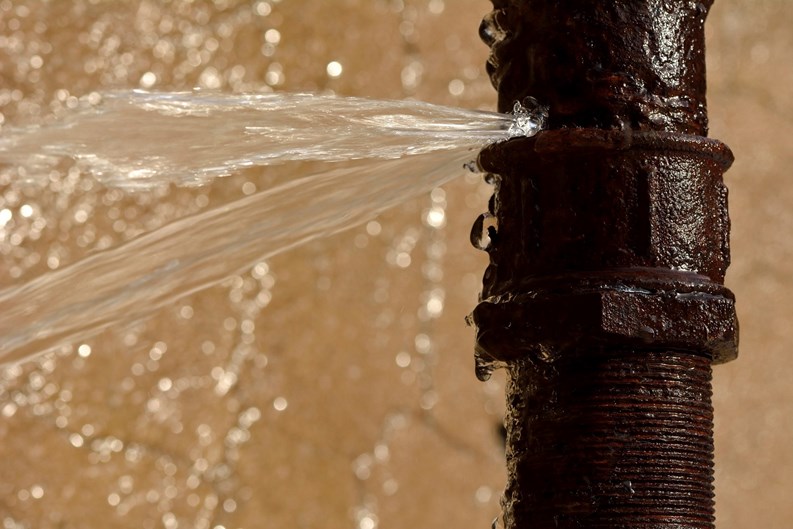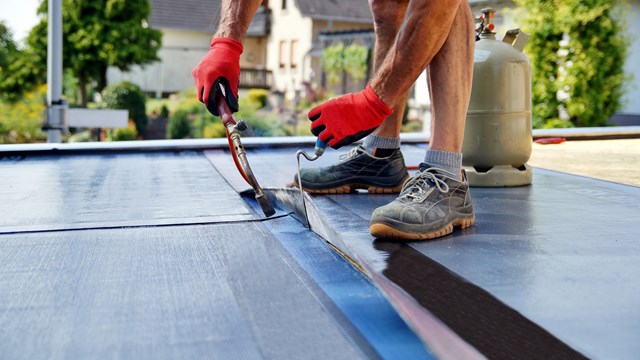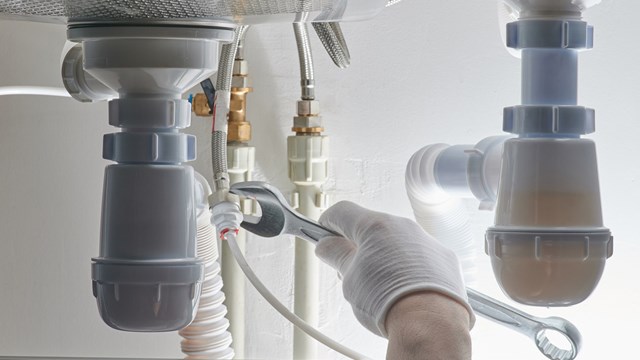Plumbing. It’s one of those things for which we all should be grateful, but about which we rarely ever give a thought—at least not until we see water seeping out from under the bathroom door. Fortunately, if and when things go wrong, there are plenty of professionals out there to remedy the problem. Even better, in most of our co-op and condo buildings, there are dedicated staff members working to maintain and service our plumbing systems with the goal of preventing problems before they ever start.
A Look Back
Plumbing refers to the system of pipes, tanks and other structures required to supply water, heat and sanitation for a building or dwelling. And it has been a concern for humans for millennia. The earliest known evidence of drains and primitive toilet technology were found among the 5,000 to 8,000-year-old Neolithic settlements at Skara Brae on the coast of Scotland’s Orkney Islands.
Water-carrying pipes and cesspools also existed thousands of years ago in the ancient civilizations of Sumer, Akkad and Babylon in the Middle East. Halfway around the world in Mesoamerica, ancient Mayan plumbing included underground aqueducts, flush toilets and household limestone water filters.
The Romans had a knack for plumbing, and even get credit for the word’s origins, which derives from plumbum, the Latin word for lead. From public bathhouses to massive underground sewer systems, there is no doubt the Romans were into their plumbing systems. Not that they were perfect at it, of course. Case in point; while many households did have private indoor toilets, few of those were connected to the main sewer system for fear of home invasions by rats, and the occasional eruption of flames from underground gas build-ups.
After Rome fell, most Europeans got lazy and reverted to collecting waste in chamber pots, which were simply dumped out windows into the streets—leading not only to a truly disgusting situation for pedestrians, but also to regular outbreaks of typhoid and cholera that killed thousands. Things began to get (arguably) better when Europeans began using small rivers and waterways to guide waste-laden water away from city centers. Of course, this made those rivers and waterways into reeking, profoundly polluted sewers...but at least there was less poo in the streets.
In the United States, the first public sewer systems were built in the late 1850s in Chicago and Brooklyn. The first American patent for a fixed water closet was granted in 1857, but the style of toilet we think of today did not come onto the market until the late 1890s.
Running water remained an elusive goal for much longer, with only about five percent of the US population having it by the end of the Civil War. Most cities would have it by the 1930s, but many rural areas had to wait until the mid 1940s before they could turn on a tap and have fresh water flow into their homes.
Fast Forward
In short, life for us modern Americans is pretty good when it comes to plumbing. Whether living in a single-family home or a multifamily residential building, the concepts remain the same when it comes to piping in fresh water and carrying waste away. Today, cast iron piping is gone and, according to a plumbing expert in Secaucus, water distribution systems are now made predominantly of copper or plastic. “Thirty or 40 years ago, brass piping was used for potable water, but now there’s a mix of copper and PEX water piping, the latter being a new plastic piping popular for water distribution,” he says. When it comes to New Jersey in particular, the expert explains that even though there’s a standardized plumbing code throughout the state, each municipal authority will dictate to local plumbers which materials they will allow in that particular municipality.
And things don’t differ wildly between the tall and the small. “There are mostly similarities when comparing high-rise to single-family homes,” says Harris Clark of Sanitary Plumbing & Heating Corp., based in the Bronx. “Water still comes into the building from a single source – either the municipality or a well, perhaps. Waste still leaves into a singular source – either a city sewer or septic-type system.”
The main difference is that “The scale is obviously amplified in a high-rise,” says Clark. “The piping needs to be larger. The quantity of pipes will be increased to serve multiple lines of apartments or individual bathroom lines.”
“Another difference,” says Clark, “is that you are sharing space with others. Their habits can affect you. For example, if there is a blockage in a waste pipe on the second floor, other tenants on that floor, as well of tenants in the floors above, may find water backing up into their apartments.”
The height of a building also can make a difference for some residents, Clark continues. “In buildings with more than six stories, the domestic water is usually distributed from the roof, from a roof tank. This can become problematic for tenants in some penthouses or other upper floor apartments where the laws of gravity fail to generate adequate water pressure,” he says.
Problems Add Up—Drop By Drop
As with any system within a co-op or condo building, problems can arise with plumbing. According to Philip Kraus of Fred Smith Plumbing & Heating Company in Manhattan, the most common issues include “leaks, broken piping and valves, clogged drains, defects in hot water heating equipment and controls, buildup of scale and corrosion in piping and tanks, defective pressure reducing valves and defective plumbing fixtures and fittings.”
Says Stuart Liben of NYC Plumbing & Heating Inc. in Brooklyn, “Depending on the age of the building and how well the plumbing was installed, the issues can differ. I think a main reason why some buildings work better than others is regular maintenance. A competent person taking care of issues as they occur makes all the difference.”
Of course as parts of a plumbing system age, deterioration is an inevitability—but human error and thoughtlessness definitely play a part in plumbing problems, says the Secaucus-based plumbing expert. He adds that residents should only discard toilet paper that adequately breaks down,a adding that people frequently throw napkins or paper towels into toilets, resulting in problematic stoppages.”
Staying Ahead of the Game
One of the best ways to avoid major plumbing issues in a co-op or condo building—no matter the size or scale – is through regular maintenance. “A periodic flushing and draining of the main line to remove corrosion products that come in from the street” is advisable, says Kraus. “Corrosion products and sediments coming in from the street can foul piping, controls and plumbing fixtures. [Building staff] should also observe all system pressures, gauges and thermometers on a daily basis.”
Clark also recommends active evaluations and long-term preparations for the building’s piping system. He encourages the maintenance of a visual checklist of any exposed building piping to be proactive in its replacement. “In addition, when a unit undergoes a renovation, make sure a visual inspection is completed to replace any piping that may show signs.”
Building staff should be diligent in creating and following up on a comprehensive maintenance plan. “If backups are prevalent, regularly scheduled drain maintenance is recommended,” says Clark. Staff also should ensure that “The water riser valves are operating properly for each line. If a leak occurs, this can help isolate the issue to only the affected line and not shut down the entire building unnecessarily.”
When people hear stories about flooding in a building due to a plumbing issue, talk sometimes turns to a backflow valve. “Backflow prevention devices are used as safety devices,” says Kraus. “They are used to make sure that once water enters a particular area, it can not “go back” and become harmful to a larger area.”
Kraus shares an example. “Water enters a boiler, where it is used to create heat,” he says. “Occasionally, the boiler is treated with a chemical to help the boiler operate efficiently. At the same time, say the local fire department opens a hydrant right outside the building. Since they require such a large amount of water to help put out a fire, the water from the building and the boiler may be siphoned from inside the building. Without a backflow preventer, the chemically mixed water may now end up in the building’s water supply, and possibly the water supply of the entire block. The backflow preventer acts as a barrier. If such siphoning action occurs, the water will instead empty out onto the building drain through a discharge port in the backflow’s design”
Backflow devices can be complex beasts and should not be installed by amateurs. “They should be installed and maintained on a regular basis to adhere to state and local regulations,” says Liben.
Lending a Hand
No one wants a plumbing problem, especially in their own unit. Fortunately, there are a number of things residents can do to help ease the pressure on their building’s plumbing system. “Be gentle when turning handles; don’t allow items other than water and waste to go down drains, and call for help or ask questions when you see something that doesn’t seem right,” says Liben. “Don’t allow excess water to flow on floors from showers or sinks.”
Clark encourages unit owners and shareholders to “always check to make sure the plumbing fixtures are 100 percent closed when not in use. Always make sure toilets are not running. Report any signs of leaks to building staff as soon as possible.”
Who to Call
When plumbing trouble does rear its inopportune head, it can be difficult to decide who exactly should tackle the problem. If it’s in a unit, should the resident pull out the toolbox and fire up the YouTube how-to videos? Or should the building’s super handle the job? When should a professional plumber be called in to handle the situation?
In a multifamily residential building, in general, “Fixture repairs could be handled by the building staff,” says Kraus. “Most other repairs have to be filed with the Department of Buildings by a licensed plumber.”
Clark agrees that general fixture repairs such as faucets, toilets and showers can be handled by building staff and adds, “Any type of piping replacement requires the services of a master licensed plumbing company.”
So unless your super also happens to be a plumber, “Supers shouldn’t handle any plumbing, because they’re not licensed by the state of New Jersey, nor are they insured,” explains a plumbing expert. According to him there have been instances of handymen running around, doing work against code in regard to ventilation problems, or running waste or water piping. If they were to break a trap seal, they’d also be breaking the law. Supers and handymen simply aren’t versed on the codes and laws that the state puts forth to its licensed plumbers.” So when it comes to plumbing, spare yourself and your building the hassle and risk, and just call a pro.
Liben concurs. “Simple repairs like minor clogs, loose drains, dripping faucets or hair clogged in drains can be handled in-house. Some buildings have more capabilities than others.”
When it comes to plumbing, it takes foresight, planning and the commitment of the entire building to ensure that all systems run their best. With fresh water running from our faucets and whisper flushes that remove all waste, it is more than worth the effort.
Liz Lent is a freelance writer and reporter, and a frequent contributor to The Cooperator.







Leave a Comment